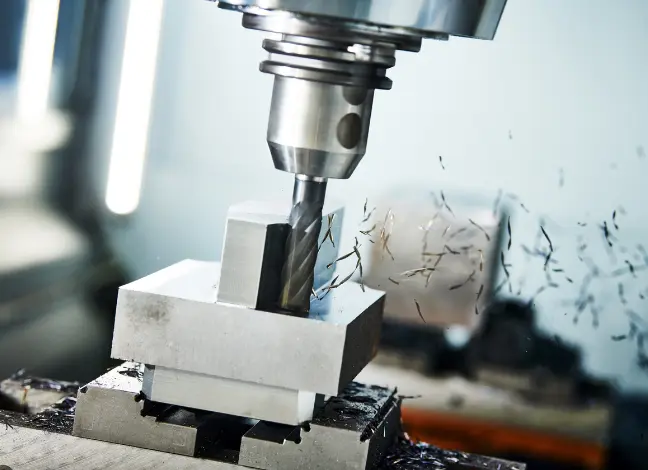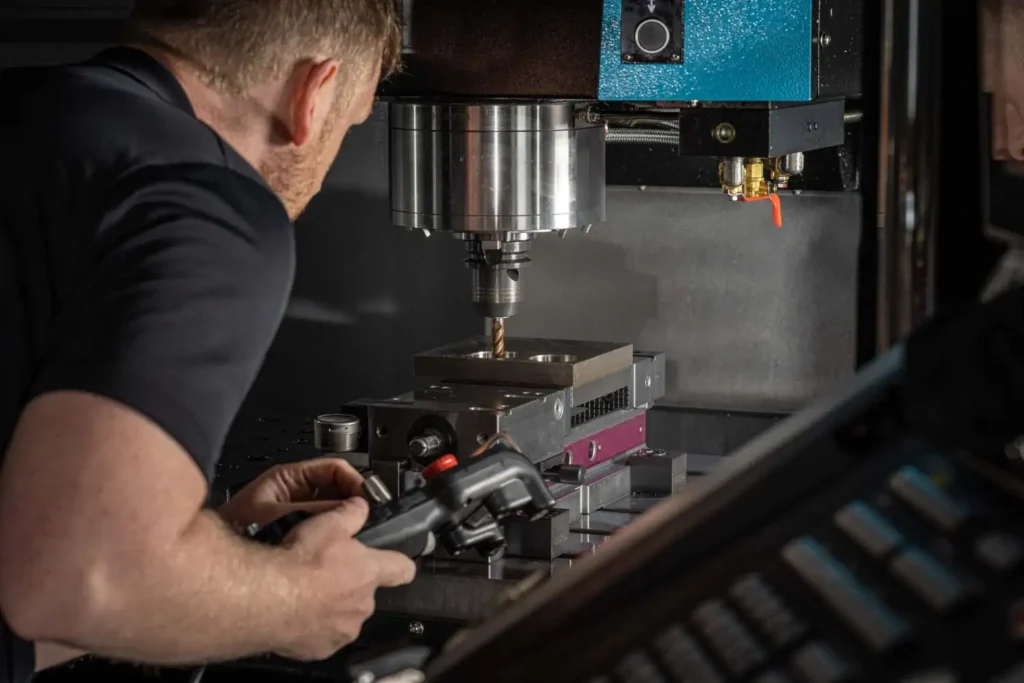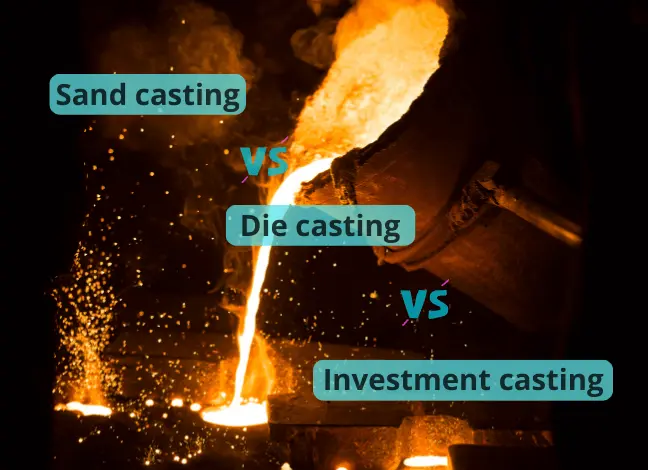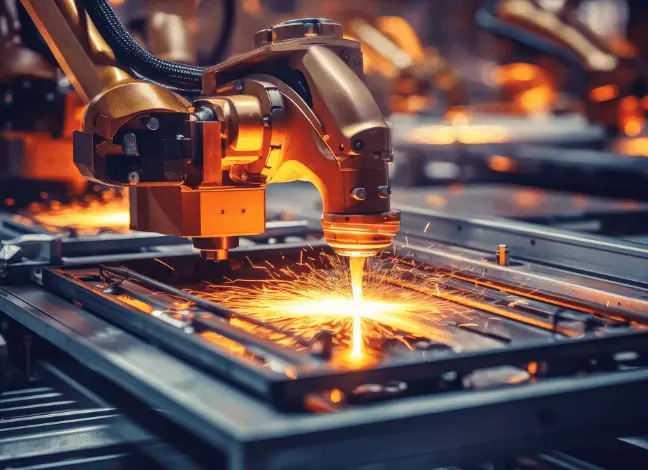Achieving CNC precision requires careful material selection and attention to geometric constraints. This guide explores how these factors impact machining accuracy, cost, and performance, offering practical tips for designing high-quality components.
Contents covered in this article
Precision in CNC (Computer Numerical Control) machining is essential for creating high-quality components. The choices made during the design phase significantly impact the final product’s accuracy and functionality. Material selection and geometric constraints are two critical factors that must be carefully considered to achieve optimal results. Understanding how these elements influence the CNC machining process can help design parts that meet exact specifications and function as intended.

This article will explore the importance of selecting suitable materials and adhering to geometric constraints when designing for CNC precision.
Material Selection: The Foundation of CNC machining
Selecting the appropriate material is the cornerstone of successful CNC machining. The material chosen affects the manufacturing process and determines the final product’s performance and durability. Working with experienced CNC machining services can provide valuable insights into the best materials for specific applications, ensuring that the final product meets all required standards.
| Material | Machinability | Strength | Heat Resistance | Corrosion Resistance | Cost | Applications |
|---|---|---|---|---|---|---|
| Aluminium | Excellent | Moderate | Moderate | Low | Low | Automotive, aerospace, consumer products |
| Steel | Moderate | High | High | High | Moderate | Heavy machinery, structural components |
| Stainless Steel | Low | High | High | Excellent | High | Medical devices, marine applications |
| Brass | Excellent | Low to Moderate | Low | Moderate | Moderate | Plumbing, electrical components |
| Titanium | Low | Very High | Excellent | Excellent | Very High | Aerospace, medical implants |
| Plastics (ABS) | Excellent | Low | Low | Low | Low | Prototypes, low-stress parts |
| Carbon Fiber | Low | Very High (Tensile) | Excellent | Moderate | High | Lightweight structures, automotive components |
Importance of Material Properties
Choosing the suitable material for CNC machining is crucial because different materials have unique properties that affect how they can be machined. Metals like aluminium and steel are famous for their strength and durability but have different machining characteristics. Aluminium is relatively easy to machine, allowing for faster production, while steel requires more robust tools and slower machining speeds due to its hardness.
Plastics, on the other hand, offer flexibility and ease of machining but may provide lower strength or heat resistance than metals. Understanding the material’s properties, such as hardness, tensile strength, and thermal stability, is essential in determining its performance during machining.
| Property | Aluminium | Steel | Titanium | ABS (Plastic) | Carbon Fibre |
|---|---|---|---|---|---|
| Density (g/cm³) | 2.7 | 7.85 | 4.51 | 1.04 | 1.6 |
| Tensile Strength (MPa) | 310-570 | 400-1500 | 900 | 41-55 | 500-1000 |
| Machinability | Excellent | Moderate | Low | Excellent | Low |
| Thermal Stability | Moderate | High | Excellent | Low | Excellent |
Matching Material with Application
The intended use of the final product should guide material selection. For example, choosing a material like titanium or stainless steel would be wise if a component is meant to withstand high stress or extreme temperatures. These materials offer excellent resistance to wear and corrosion, making them suitable for demanding environments.
Conversely, if the focus is on reducing weight while maintaining structural integrity, materials like carbon fibre or certain engineering plastics may be more appropriate. The key is to align the material’s properties with the part’s functional requirements.
Cost Considerations
While material properties are paramount, cost cannot be overlooked. Some materials, such as speciality alloys, can be expensive and unnecessary for all applications. Balancing performance with cost-effectiveness is crucial. For instance, while titanium offers exceptional strength and corrosion resistance, it is more costly and challenging to machine than aluminium. Therefore, if aluminium meets the required specifications, it might be the more practical choice.
Machinability of Materials
The machinability of a material refers to how easily it can be cut, shaped, and finished during the CNC process. Materials with high machinability require less energy and time, reducing tool wear and allowing for faster production. For example, brass and aluminium are known for their excellent machinability, making them popular choices for precision parts.
On the other hand, harder materials like stainless steel or titanium, while offering superior strength, are more challenging to machine. They require specialised tools and more precise control over machining parameters to achieve the desired accuracy. Understanding the machinability of the chosen material helps in planning the machining process and selecting the appropriate tools and techniques.
| Material | Tool Wear | Recommended Cutting Speed (m/min) | Comments |
|---|---|---|---|
| Aluminium | Low | 150-200 | Easy to machine, fast production |
| Steel | Moderate | 60-90 | Requires robust tools, moderate wear |
| Stainless Steel | High | 30-70 | High wear, requires coolant |
| Titanium | Very High | 20-40 | Requires specialised tools |
| Plastics | Very Low | 250-500 | Fast machining, minimal wear |
Geometric Constraints: Designing for Precision
Beyond material selection, the part’s geometric design plays a crucial role in determining the success of the CNC machining process. Attention to geometric details can distinguish between a functional, high-quality component and one that fails to meet specifications.

Understanding Tolerances
Tolerances define the allowable variations in a part’s dimensions. Tight tolerances are often necessary for parts that must fit together precisely or perform under specific conditions. However, achieving tight tolerances increases the complexity of the machining process, requiring more advanced equipment and techniques.
| Industry | Typical Tolerance Range (mm) | Example Components |
|---|---|---|
| Aerospace | 0.001 – 0.01 | Jet engine parts, turbine blades |
| Automotive | 0.01 – 0.1 | Engine components, transmission gears |
| Medical Devices | 0.001 – 0.05 | Surgical tools, implants |
| Consumer Products | 0.1 – 0.5 | Household appliances, electronic enclosures |
For example, aerospace components often demand extremely tight tolerances due to the critical nature of their applications. Even minor deviations can lead to significant performance issues. In contrast, parts used in less critical applications may allow for broader tolerances, simplifying the machining process and reducing costs.
Simplifying Complex Geometries
Complex geometries can present challenges in CNC machining, particularly when working with difficult materials. Sharp corners, deep cavities, and intricate designs can increase the risk of tool wear and breakage, leading to inaccuracies in the final product.
Simplifying the design by rounding corners, reducing the depth of cavities, and minimising intricate features can improve machinability without compromising the part’s functionality. For example, using fillets instead of sharp corners can reduce stress concentrations and enhance the part’s durability.
| Original Feature | Recommended Modification | Recommended Modification |
|---|---|---|
| Sharp Corners | Add fillets (rounded edges) | Reduces stress concentrations |
| Deep Cavities | Reduce cavity depth | Lowers tool wear, increases accuracy |
| Small Features | Increase feature size | Improves machinability |
| Thin Walls | Increase wall thickness | Prevents deformation during machining |
Considering Part Orientation
The orientation of the part during machining can also affect the outcome. Some geometries may require multiple setups or specialised fixtures to ensure that all features are accurately machined. This can increase the machining time and cost.
Understanding how parts will be oriented during machining can help reduce the number of setups required. For instance, designing a part that can be machined in a single setup without repositioning can enhance precision and reduce production time.
Wall Thickness and Feature Size
Wall thickness and feature size are critical considerations in CNC machining. Thin walls or small features can be challenging to machine accurately, especially in harder materials. Thin walls are prone to deformation during machining, leading to dimensional inaccuracies.
Maintaining consistent wall thickness and avoiding overly thin features can improve the part’s structural integrity and enhance the machining process’s accuracy. For example, increasing the wall thickness slightly may not significantly impact the part’s overall weight but can greatly improve its machinability.
| Material | Minimum Recommended Wall Thickness (mm) | Comments |
|---|---|---|
| Aluminum | 0.5-1.0 | Good for lightweight applications |
| Steel | 1.5-2.0 | Requires thicker walls for stability |
| Plastics (ABS) | 1.0-1.5 | Flexibility allows thinner walls |
| Titanium | 1.0-2.0 | Prevents warping during machining |
Minimising Residual Stresses
Residual stresses can develop during machining, leading to warping or distortion. These stresses are often the result of uneven material removal or thermal effects during machining.
Designing parts with uniform material thickness and avoiding abrupt changes in geometry can help minimise residual stresses. Additionally, using appropriate cooling techniques and controlling machining speeds can reduce the risk of stress development.
Balancing Precision with Practicality
Designing for CNC precision requires balancing tight tolerances and practical considerations, such as cost, production time, and material selection. While it is essential to focus on precision, it is equally important to recognise the limitations of the machining process and the materials used.
For example, a part with extremely tight tolerances may be ideal in theory. Still, if it requires costly materials and specialised machining techniques, it may not be practical for mass production. Finding the right balance ensures that the design meets the necessary specifications without becoming overly complex or expensive.
| Precision Level | Cost Implication | Machining Complexity | Application Examples |
|---|---|---|---|
| High Precision (±0.001 mm) | High | Complex setups, tight tolerances | Aerospace, medical devices |
| Moderate Precision (±0.01 mm) | Moderate | Standard machining setups | Automotive, general manufacturing |
| Low Precision (±0.1 mm) | Low | Simple setups, broad tolerances | Consumer products, non-critical parts |
Conclusion
Designing for CNC precision involves carefully selecting materials and adhering to geometric constraints to ensure that the final product meets exact specifications. By understanding the properties of different materials, considering their machinability, and accounting for geometric factors like tolerances, part orientation, and wall thickness, designers can create precise and practical parts. Achieving this balance is vital to producing high-quality components that perform as intended in their specific applications.

